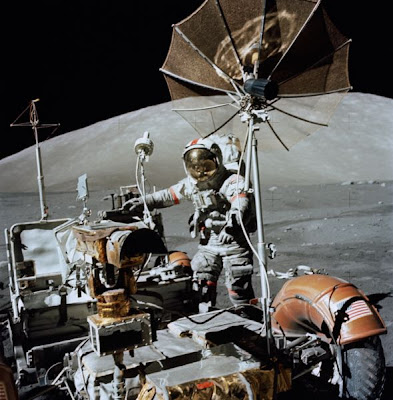Date: December 7-19, 1972
Crew: Commander Gene Cernan (38)
Command Module Pilot Ronald Evans (39)
Lunar Module Pilot Harrison J. Schmitt (37)
Command Module Call Sign: America
Lunar Module Call Sign: Challenger
Moon Landing Site: Taurus-Littrow Valley
Mission Distinctions: Sixth and final moon landing, record time on the moon of 75 hours, 22 EVA hours, and 250 pounds of samples returned to Earth for analysis.

Mission 17's insignia was the only one to actually feature the God Apollo, copying the profile of the famed Pythian Apollo sculpture in the Vatican. An American eagle with three stars represented the crew, and graphics of a spiral galaxy and Saturn indicated the "future" of the space program: the outer planets and distant stars.
Apollo 17 had the program’s only evening launch, and was witnessed as far away as Miami, where onlookers described it as like a firecracker shooting into the sky.

According to flight controllers, each Lunar mission was more difficult and ambitious than the one before, with landings at more rugged and desolate sites. Gene Kranz described it as a "Can You Top This" contest between the lunar geologists. Each crew of astronauts hoped to work harder, stay longer, and collect more moon rocks than the previous guys.
As the objectives became more scientific, it was only a matter of time before a scientist flew. Jack Schmitt was the first geologist to go into space. Apollo 17 also set up a record number of surface experiments.
Apollo 17 was Gene Cernan’s second trip to the moon and third into space. As the last to climb the ladder before the LM ascent stage rejoined the orbiting CM, he would also be the last man to walk on the moon. Enroute home, he radioed, “Apollo has been a beginning. I don’t think there will ever be an end, not as long as man is alive and willing.”

A pose you sure don't see everyday...!
Seems Cernan & Schmitt were the first humans to SING on the moon when they broke into an impromptu chorus of "Strolling Through The Park One Day" while working.
Apollo 17 would be the last of the manned lunar missions, as Apollo 18, 19 and 20 were all cancelled due to budget concerns.

Currently, the Apollo 17 Command Module America is on display at the Lyndon B. Johnson Space Center in Houston, Texas. The ascent stage of the Lunar Module Challenger impacted the moon on 19.96 N, 30.50 E, on December 15, 1972. The descent stage is still in the mountains of Taurus beside the giant crater of Littrow, near the Sea of Serenity.


































































